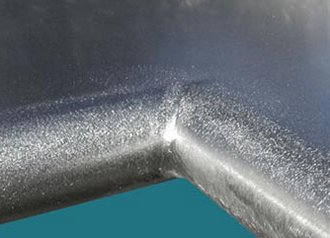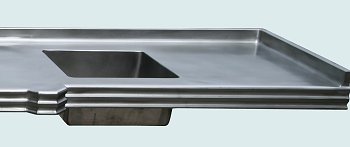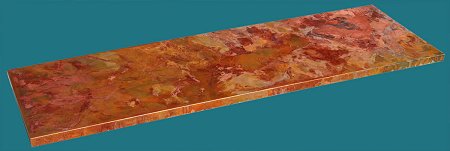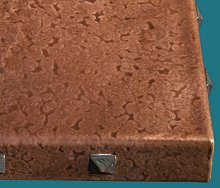Metal Countertops
Metal countertops may not be the first thing that comes to mind when considering an update to your kitchen, but they're definitely unique and offer a distinctive look to any home.
In reality, metal countertops aren't new. Like wood countertops, they were some of the earliest forms of the kitchen 'workbench', before the laminate age took over. You could say that they're making a comeback of sorts, as people look to new materials to set their kitchen apart.
If you like choices, metal counters offer numerous options. Not only do you have a choice of metals but copious finishes too. You can even get some metal tops with splashes of color. Copper can be treated to produce color shades that rival even the most dramatic granite color variations.
Are they showpieces or workhorses? That depends on the kind of metal you choose. Some metal countertops stand up to the wear and tear better than others. But with the choices that are available, you can find the right match for the kind of duty your countertops will see.
What Exactly Are Metal Counter Tops?
 Photo Courtesy of Handcrafted Metal
Photo Courtesy of Handcrafted Metal
The first thing you should know about metal countertops is that they are not solid slabs of metal, equal to the thickness of your countertop.
Rather, they are relatively thin sheets of metal that are formed and fastened to a wood or similar backing material. The metal wraps around the edges to give the countertop a finished look. In most cases the corners are either welded or soldered, depending on the material and fabricator, and ground smooth as needed so there is no appearance of a seam.
A nice feature of metal is that it's non-porous, with good hygienic qualities. Most metal countertops are heat-proof and will take a hot pan better than laminate or solid surface.
But like other facets of life, there is no free lunch and a metal countertop's armor does have its chinks. For example, metals other than stainless steel will develop a patina and change color over time. That's not a bad thing but if you want to retain the original finish, you'll need to apply a sealer or wax to prevent this color change.
 Photo Courtesy of Handcrafted Metal
Photo Courtesy of Handcrafted Metal
Also, metal is malleable, which means a metal countertop can be dented, despite the wood backing underneath. And once it's dented, there's no way of fixing it. You might think that your countertop won't see rough duty but don't discount inadvertently dropping a bottle of wine onto the surface.
Metal Choices And Their Pros & Cons
There are several different types of metal that are used to fashion kitchen countertops. Stainless steel is a well known surfacing material but if you're not a stainless fan, don't fret. There are several other choices that offer different looks and style.
Stainless Steel Countertops
Stainless steel is arguably the more commonly recognized variety of metal countertops. It's used extensively in commercial applications like restaurant kitchens and cafeterias due to its great qualities. It's easily cleaned, almost impossible to stain, indifferent to water and spills.Photo Courtesy of Handcrafted Metal
Some are of the opinion that it can look too industrial but it really depends on how it's designed into the rest of the kitchen. Stainless steel countertops don't have to make your kitchen look like a science lab when combined with the right design elements.
Stainless steel is manufactured in different "grades". These grades vary based on the particular constituents in the steel and the properties they impart. A good grade of steel for kitchen countertops is type 304 stainless steel. It offers high strength and good scratch resistance (although it's not scratch-proof) as well as good aesthetic qualities.
The surface finish of stainless steel is classified by a numbering system and indicates the amount of polish and resulting reflectivity. The numbering system ranges from 0 to 8 with the higher numbers representing higher polishes and reflectivity. Highly polished surfaces will show scuffs and fingerprints and will also reflect a lot of light. If you want to minimize fingerprints and scratches, a #4 finish is a good choice.
Highs, Lows & Other Considerations
|
Copper Countertops
Copper is a material that's been used for centuries and has proven it's mettle (couldn't resist the pun) under all sorts of trying conditions. Photo Courtesy of Handcrafted Metal
Photo Courtesy of Handcrafted Metal
Copper will develop a reddish-brown patina as it ages. You can maintain a uniform color if you apply a wax or sealer which some fabricators apply during manufacture. Sealers however can be scratched by knives and other sharp implements negating the sealing benefits, so keep this in mind if you want to maintain that uniform look.
Copper's relative softness means it will dent and scratch more easily than steel. Despite this minor drawback however, copper countertops impart a warm ambiance to a kitchen, a sort of mix between old-world and modern style.
Certain alloys of copper are also antimicrobial. That means that that they can help reduce the amount of certain types of bacteria that come in contact with the metal. Be advised however that the U.S. Environmental Protection Agency (EPA) regulates this issue and that copper products that truly have this capability must be registered with the EPA. You can read more about that topic at the EPA website and the copper industry's informational site dealing with copper's antimicrobial characteristics.
Highs, Lows & Other Considerations
|
Zinc Countertops
If you really want to be different from the Joneses, tell them you have zinc countertops. If your familiarity with zinc is limited to sunblock and lozenges that fight the common cold, you're in for a surprise. Whether you know it or not, zinc has many uses and countertops are one of them. Photo Courtesy of Handcrafted Metal
Photo Courtesy of Handcrafted Metal
Zinc has a whitish to silvery-gray appearance when "new" but develops a darkened blue-gray patina over time as it oxidizes. If you prefer to keep the fresher look you can apply a beeswax coating periodically. Zinc countertops are made like other metal countertops, from sheets of zinc material formed over a wood or other substrate backing. Zinc is also a safe material and it's actually essential for life, being an important element in the proper function of the human body.
Zinc is a relatively soft material and has a much lower melting point than copper or stainless steel. It will scratch and show knife marks and although it won't melt, it might be susceptible to distortion if very hot items are placed on it.
 Photo Courtesy of Handcrafted Metal
Photo Courtesy of Handcrafted Metal
Scratches can be polished out but deep knife cuts might be more difficult to remove depending how deep they are so you'll want to avoid cutting and chopping on a zinc countertop.
Zinc can be joined by welding or soldering depending on who's fabricating the countertop and the thickness of the material being used. That means you can incorporate an integral zinc sink if you so desire. The sink is welded to the countertop and the seams ground flush for a seamless transition between the countertop surface and the sink.
Highs, Lows & Other Considerations
|
Pewter Countertops
Pewter is a soft metal that's silvery in color but ages to a duller gray over time. Pewter's not a pure metal like zinc or copper but rather an alloy which is a combination of different metals. Pewter is mostly tin, roughly 85 to 95 percent, with a small amount of copper or other metals like bismuth or antimony. Some pewter alloys contain lead but aren't (and shouldn't be) used for items that come in contact with food. Because it's a relatively soft metal pewter will tend to show dents if it's struck hard enough. Photo Courtesy of Handcrafted Metal
Photo Courtesy of Handcrafted Metal
Pewter actually has a beautiful look and offers a nice alternative to the slightly more clinical look of stainless steel. Pewter's silvery color is muted somewhat in that it's not bright like chrome. Rather, it has a softer, more matte appearance. It's softness also has an upside in that the metal is easily shaped and stamped, allowing interesting and artistic designs to be incorporated into the surface. It's a more traditional look but might be an interesting focal point or a different style choice in an eclectic kitchen.
Highs, Lows & Other Considerations
|
So What's New And Interesting?
OK, so you know a little bit about the more mundane facts of metal countertops. But what about some of the more interesting and handy features, the stuff that's a little more exciting?
Check out these features and see if they stir up visions of potential metal countertops in your kitchen.
- Eye-Catching (and wear-camouflaging) Patterns On Stainless Steel
A stainless steel metal countertop doesn't have to have a monochromatic look. Different brush finishes add a whole new twist to the look of stainless and add some visual dimension to what can sometimes be a boring surface. Not only that however, these types of finishes do a great job masking everyday use since any scratches tend to get muted by the "micro-scratches" of the patterned finish. Photo Courtesy of Handcrafted Metal
Photo Courtesy of Handcrafted Metal - Variable Colors And Patinations On Copper
Depending on your tastes you can have some "built-in" patinas with your copper countertops. These color and swirl patterns come to you courtesy of heat and chemicals applied by the manufacturer, prior to delivery. Photo Courtesy of Handcrafted Metal
Photo Courtesy of Handcrafted Metal - Integral Sinks
We mentioned it above but a picture's worth a thousand words. If you like the look of an integral sink, similar to that seamless look you get with solid surface sinks and countertops, you can get them with a metal countertop too. Photo Courtesy of Handcrafted Metal
Photo Courtesy of Handcrafted Metal - A Hammered Finish On Copper
Looking for a textured rather than smooth countertop surface? Try one of the hammered or reverse hammered effects like those shown on these copper countertops.

Photo Courtesy of Handcrafted Metal - Decorative Edging
You're not limited to a simple square or waterfall edge with metal countertops, particularly with the softer metals like zinc and pewter. These materials lend themselves to some very interesting details. Some manufacturers actually make elaborate pewter stampings up to several inches tall, that are then soldered (pewter is soldered, not welded) to the edge of the countertop surface. The result is a bold and substantial edge to the countertop, giving it a very substantial look.

Photo Courtesy of Handcrafted Metal
Needless to say, regardless of which type of metal countertop you're considering, there are plenty of options and treatments that can dress them up and give them individuality.
Where Can I Get Them?
There are several ways to get a metal countertop. There are companies that specialize in making both custom as well as pre-made metal counters. Many of these sources will ship nationwide. The other option involves using a countertop or metal fabrication shop that's in your local area.
- Sourcing Local Fabricators
Although metal countertops are becoming more popular, they're still not as mainstream as laminate, solid surface or even stone. But despite that fact, there may be countertop fabricators in your area that can install a metal countertop.Look in the phone book under "countertops" or better yet, perform a local internet search using Google or MSN "maps", or Yahoo's "local" search functions and then input "metal countertops" and your local city.
The benefits of using a local source include face-to-face business relations and the conveniences of the close proximity between your home and the installer's business.
- Fabricate Them Yourself
This process probably isn't for the faint of heart or clumsy of hand. However, if you're a skilled do-it-yourself'er this may be a possibility. There are sources that make materials specifically for metal countertops. You can buy the metal and fabricate the counters on your own. The challenges lie with the welding and/or soldering that comes along with getting finished corners. - Get Them From Metal Countertop Specialty Sources
Though they may not be local, one of the easier ways to obtain metal countertops is to order them through a specialty fabricator. These sources make both pre-made countertops and custom counters made to your specifications. Once the countertops are shipped to you you'll need to install them yourself or hire a contractor to install them for you.
Here's More Related Info That Might Be Helpful...
Choosing Kitchen Countertops - If you're still undecided learn more about the countertop choices you have and their pros and cons.
Butcherblock Countertops - How to choose butcherblock countertops.
Engineered Stone Countertops - Engineered stone countertops take the benefits of stone and use a bit of technology to eliminate the undesirable qualities.
Stone Countertops - Discover what's available in the realm of natural stone countertops and how to make the best choice.
Laminate Countertops - There's still a lot to like about them such as durability and low cost.
Solid Surface Countertops - For a seamless look there's no match for solid surface counters.
Quartz Countertops - Quartz countertops are a form of engineered stone that take the best of what stone has to offer to make a beautiful and easily-maintained countertop surface.
Wood Countertops - Wood makes for a beautiful as well as functional work top.
